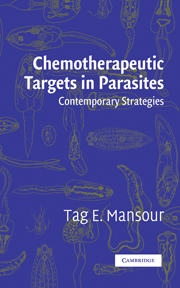Book contents
- Frontmatter
- Contents
- Preface
- Acknowledgments
- 1 The Search for Antiparasitic Agents
- 2 Biophysical, Genomic, and Proteomic Analysis of Drug Targets
- 3 Energy Metabolism in Parasitic Helminths: Targets for Antiparasitic Agents
- 4 Antimalarial Agents and Their Targets
- 5 Antitrypanosomal and Antileishmanial Targets
- 6 Targets in Amitochondrial Protists
- 7 Neuromuscular Structures and Microtubules as Targets
- 8 Targets in the Tegument of Flatworms
- Epilogue
- Index
- References
5 - Antitrypanosomal and Antileishmanial Targets
Published online by Cambridge University Press: 11 August 2009
- Frontmatter
- Contents
- Preface
- Acknowledgments
- 1 The Search for Antiparasitic Agents
- 2 Biophysical, Genomic, and Proteomic Analysis of Drug Targets
- 3 Energy Metabolism in Parasitic Helminths: Targets for Antiparasitic Agents
- 4 Antimalarial Agents and Their Targets
- 5 Antitrypanosomal and Antileishmanial Targets
- 6 Targets in Amitochondrial Protists
- 7 Neuromuscular Structures and Microtubules as Targets
- 8 Targets in the Tegument of Flatworms
- Epilogue
- Index
- References
Summary
The hemoflagellates of the genus Trypanosoma and of the genus Leishmania belong to the family of Trypanosomatidae. They are blood or tissue parasites that infect humans and other vertebrates. Trypanosoma brucei gambiense and T. brucei rhodesiense are the causative organisms of African trypanosomiasis (sleeping sickness), which is prevalent in central and eastern Africa. T. brucei can also infect all domestic animals. The vector of this disease is tsetse flies of the genus Glossina. Once the fly bites the mammalian host the metacyclic trypanosomes (mature stages in fly salivary glands) cause local skin “chancre” and then migrate to the lymphatic system of the host and eventually to the bloodstream. After approximately a month the parasites cross the choroid plexus into the brain and cerebrospinal fluid. The “sleeping” symptoms, such as physical depression, mental deterioration, and even coma, then appear in the host. The causative organism of American trypanosomiasis, also known as Chagas' disease, is Trypanosoma cruzi. It is present in South and Central America, especially in Brazil, Argentina, and Mexico. Vectors for transmission are members of Triatominae, insects found in Latin America. After having a blood meal from the human host the metacyclic forms of the trypanosome enter the gut of the insects and are eventually released in the insects' feces. When the feces are deposited on the skin of the host and rubbed they penetrate the skin and enter host cells where they are transformed to amastigotes, which cause chronic local inflammatory swelling.
- Type
- Chapter
- Information
- Chemotherapeutic Targets in ParasitesContemporary Strategies, pp. 90 - 128Publisher: Cambridge University PressPrint publication year: 2002
References
- 1
- Cited by



